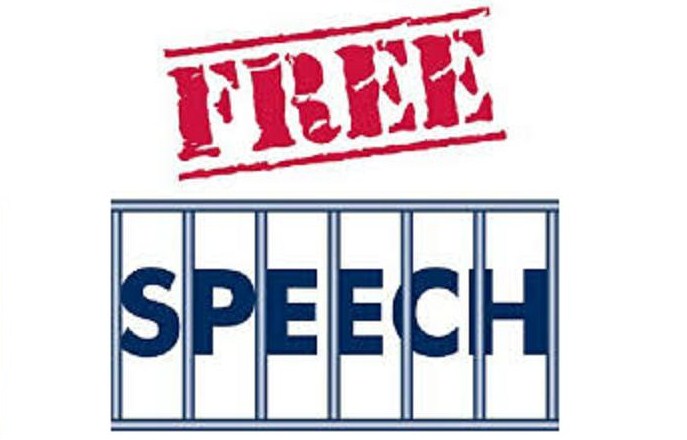07 February 2019
Freeing Speech
Government acts at last.
By Lynda Goetz
 It has been a long time coming, but finally the Government has published a 53-page document setting out uniform Guidance on the issue of free speech in universities. This, as those who have an interest in such things (and of course those who read The Shaw Sheet) are well aware, has been in jeopardy in recent years from militant students ‘no-platforming’ those with whose opinions they disagree; demanding ‘safe spaces’ where people are protected from opinions they find disturbing or offensive and requiring ‘trigger warnings’ where lecturers are obliged to give pre-warning of ‘distressing’ subjects (such as rape) which may be touched upon during lectures. The increasing curtailment of free speech has not, in many cases, been frowned upon by university academics and authorities, who have instead kowtowed or even colluded with students (as Baroness Deech, the cross-bench peer, commented back in 2017) to shut down the wide-ranging diversity of opinion and lively debate which should be a part of university life.
It has been a long time coming, but finally the Government has published a 53-page document setting out uniform Guidance on the issue of free speech in universities. This, as those who have an interest in such things (and of course those who read The Shaw Sheet) are well aware, has been in jeopardy in recent years from militant students ‘no-platforming’ those with whose opinions they disagree; demanding ‘safe spaces’ where people are protected from opinions they find disturbing or offensive and requiring ‘trigger warnings’ where lecturers are obliged to give pre-warning of ‘distressing’ subjects (such as rape) which may be touched upon during lectures. The increasing curtailment of free speech has not, in many cases, been frowned upon by university academics and authorities, who have instead kowtowed or even colluded with students (as Baroness Deech, the cross-bench peer, commented back in 2017) to shut down the wide-ranging diversity of opinion and lively debate which should be a part of university life.
One aspect, of which I personally had not been aware, was how far back the issue of no-platforming actually goes. Apparently, this was a policy drafted by Trevor Phillips for the National Union of Students (NUS) in the 1970s in an effort to stop Far-Right groups like the National Front addressing students. He told The Sunday Telegraph, “The point was very simple: to prevent people who belonged to violent, racist groups from organising on campus in the same way as other societies”. However, even he feels that the policy has been used increasingly in an “ugly” and “authoritarian” way.
The origin of the term ‘safe space’ is believed to have originated even earlier, in the 1960s with the women’s movement or possibly also with the LGBTQ movement, referring to both a physical safe space and the idea of a community coming together. It has become ubiquitous over the last few years, particularly in universities where it has come to be associated with a threat to free speech.
The guidance document is the first time in 30 years that a government has intervened to protect free speech at universities and follows firstly an inquiry in 2017 by the Joint Committee on Human Rights into the state of free speech in UK universities and then in May 2018 a summit for leaders in the higher education sector called by the then Universities Minister, Sam Gyimah. It was agreed that the sector should support the Equality and Human Rights Commission to produce new guidance on freedom of expression. The document published on 2nd February was produced as a collaborative exercise between a number of bodies including the Education Department, the Home Office, the NUS, the Office for Students (OfS) and the Charity Commission. It must be noted this document is exactly what it calls itself – guidance. It is not statutory or regulatory and does not replace any existing legislation, including the Prevent (anti-terrorist) legislation. What it does is to point out and elucidate the duties of Higher Education Providers (HEPS) and Student Unions under existing legislation, including the 1986 Education Act and the 1998 Human Rights Act.
The guidance document starts with an introduction setting out its core ideas and key points. The core ideas are as follows:
- Everyone has the right to free speech within the law.
- Higher education providers should always work to widen debate and challenge, never to narrow it.
- Any decision about speakers and events should seek to promote and protect the right to freedom of expression.
- Peaceful protest is a protected form of expression; however, protest should not be allowed to shut down debate or infringe the rights of others.
- Freedom of expression should not be abused for the purpose of unchallenged hatred or bigotry. Providers of higher education should always aim to encourage balanced and respectful debate.
Section 3 points out in simple language where the law allows for limitations on freedom of speech, for example if it would be in breach of criminal law under say the Public Order Act 1986 or any of the Terrorism Acts or whether the civil law action of harassment under the 2010 Equality Act has been committed. It also considers the duties of HEPs and SUs under the charity laws. Section 4 identifies the ‘other legal duties HEPs need to consider in relation to freedom of expression, including Prevent duty and the public sector equality duty’ and section 5 is a very brief section on how SUs and HEPs can work together to support freedom of expression. Section 6 is directed specifically at advising HEPs ‘how to fulfil their functions under Section 43 of the Education (No 2) Act 1986 (the s.43 duty) which places a legal duty on universities and other HEPs to ‘take ‘reasonably practicable’ steps to ensure freedom of speech within the law for their members, students, employees and visiting speakers’. It sets out suggestions as to what ‘reasonably practicable’ might mean in practice and contains an illustrative chart.
Interestingly, section 7, which addresses directly the policies of no-platforming, safe spaces and trigger warnings, points out that although SUs are charities the NUS is not. It is therefore not subject to the laws relating to charities, nor is it subject to the s43 responsibility. Under certain circumstances HEPs may be under a s43 duty to enable speakers invited by a society, but banned by an SU, to speak. Various case studies are given as examples. This section also gives information on the role of the recently created OfS as a body to which notifications can be made on issues of concern including free speech. Annex A gives more information on how this role of the OfS will work.
The whole tenor of this document is reasonable and simple. It attempts, as current Universities Minister Chris Skidmore points out, to define coherently the duties of universities and student unions around the issue of free speech. This document sets out to demystify and clarify the sometimes conflicting, and certainly disjointed, pieces of legislation in existence on the subject of free speech. If it enables universities to stop behaving like ‘frightened children’ (to use Trevor Phillips words) in the face of bullying by minority voices with an axe to grind then it can only be a good thing. Safe spaces may not, as the guidance says, be unlawful, but nor are they very stimulating. The first of the six key points in the introduction states that “Everyone has the right to express and receive views and opinions, including those that may offend, shock or disturb others”. Perhaps, listening to the outrage that appears to have been generated by Liam Neeson’s honesty about his feelings 40 years ago, it is not just universities that need to remember this.


